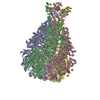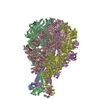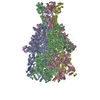+ Open data
Open data
- Basic information
Basic information
| Entry | Database: EMDB / ID: EMD-10034 | |||||||||
|---|---|---|---|---|---|---|---|---|---|---|
| Title | Cryo-EM structure of Xenorhabdus nematophila XptA1 | |||||||||
 Map data Map data | Cryo-EM density map of Xenorhabdus nematophila XptA1 | |||||||||
 Sample Sample |
| |||||||||
 Keywords Keywords | Toxin / membrane permeation / translocation / complex | |||||||||
| Function / homology |  Function and homology information Function and homology informationTcA receptor binding domain / TcA receptor binding domain / ABC toxin, N-terminal domain / ABC toxin N-terminal region / Insecticidal toxin complex/plasmid virulence protein / Tc toxin complex TcA, C-terminal TcB-binding domain / Neuraminidase-like domain / Salmonella virulence plasmid 28.1kDa A protein / Tc toxin complex TcA C-terminal TcB-binding domain / Neuraminidase-like domain Similarity search - Domain/homology | |||||||||
| Biological species |  Xenorhabdus nematophila (bacteria) Xenorhabdus nematophila (bacteria) | |||||||||
| Method | single particle reconstruction / cryo EM / Resolution: 2.84 Å | |||||||||
 Authors Authors | Roderer D / Leidreiter F | |||||||||
| Funding support |  Germany, 1 items Germany, 1 items
| |||||||||
 Citation Citation |  Journal: Sci Adv / Year: 2019 Journal: Sci Adv / Year: 2019Title: Common architecture of Tc toxins from human and insect pathogenic bacteria. Authors: F Leidreiter / D Roderer / D Meusch / C Gatsogiannis / R Benz / S Raunser /  Abstract: Tc toxins use a syringe-like mechanism to penetrate the membrane and translocate toxic enzymes into the host cytosol. They are composed of three components: TcA, TcB, and TcC. Low-resolution ...Tc toxins use a syringe-like mechanism to penetrate the membrane and translocate toxic enzymes into the host cytosol. They are composed of three components: TcA, TcB, and TcC. Low-resolution structures of TcAs from different bacteria suggest a considerable difference in their architecture and possibly in their mechanism of action. Here, we present high-resolution structures of five TcAs from insect and human pathogens, which show a similar overall composition and domain organization. Essential structural features, including a trefoil protein knot, are present in all TcAs, suggesting a common mechanism of action. All TcAs form functional pores and can be combined with TcB-TcC subunits from other species to form active chimeric holotoxins. We identified a conserved ionic pair that stabilizes the shell, likely operating as a strong latch that only springs open after destabilization of other regions. Our results provide new insights into the architecture and mechanism of the Tc toxin family. | |||||||||
| History |
|
- Structure visualization
Structure visualization
| Movie |
 Movie viewer Movie viewer |
|---|---|
| Structure viewer | EM map:  SurfView SurfView Molmil Molmil Jmol/JSmol Jmol/JSmol |
| Supplemental images |
- Downloads & links
Downloads & links
-EMDB archive
| Map data |  emd_10034.map.gz emd_10034.map.gz | 18.6 MB |  EMDB map data format EMDB map data format | |
|---|---|---|---|---|
| Header (meta data) |  emd-10034-v30.xml emd-10034-v30.xml emd-10034.xml emd-10034.xml | 12.4 KB 12.4 KB | Display Display |  EMDB header EMDB header |
| Images |  emd_10034.png emd_10034.png | 73.3 KB | ||
| Filedesc metadata |  emd-10034.cif.gz emd-10034.cif.gz | 6.8 KB | ||
| Archive directory |  http://ftp.pdbj.org/pub/emdb/structures/EMD-10034 http://ftp.pdbj.org/pub/emdb/structures/EMD-10034 ftp://ftp.pdbj.org/pub/emdb/structures/EMD-10034 ftp://ftp.pdbj.org/pub/emdb/structures/EMD-10034 | HTTPS FTP |
-Validation report
| Summary document |  emd_10034_validation.pdf.gz emd_10034_validation.pdf.gz | 232.8 KB | Display |  EMDB validaton report EMDB validaton report |
|---|---|---|---|---|
| Full document |  emd_10034_full_validation.pdf.gz emd_10034_full_validation.pdf.gz | 232 KB | Display | |
| Data in XML |  emd_10034_validation.xml.gz emd_10034_validation.xml.gz | 7.1 KB | Display | |
| Arichive directory |  https://ftp.pdbj.org/pub/emdb/validation_reports/EMD-10034 https://ftp.pdbj.org/pub/emdb/validation_reports/EMD-10034 ftp://ftp.pdbj.org/pub/emdb/validation_reports/EMD-10034 ftp://ftp.pdbj.org/pub/emdb/validation_reports/EMD-10034 | HTTPS FTP |
-Related structure data
| Related structure data |  6rw8MC  6rw6C  6rw9C  6rwaC  6rwbC M: atomic model generated by this map C: citing same article ( |
|---|---|
| Similar structure data |
- Links
Links
| EMDB pages |  EMDB (EBI/PDBe) / EMDB (EBI/PDBe) /  EMDataResource EMDataResource |
|---|
- Map
Map
| File |  Download / File: emd_10034.map.gz / Format: CCP4 / Size: 244.1 MB / Type: IMAGE STORED AS FLOATING POINT NUMBER (4 BYTES) Download / File: emd_10034.map.gz / Format: CCP4 / Size: 244.1 MB / Type: IMAGE STORED AS FLOATING POINT NUMBER (4 BYTES) | ||||||||||||||||||||||||||||||||||||||||||||||||||||||||||||
|---|---|---|---|---|---|---|---|---|---|---|---|---|---|---|---|---|---|---|---|---|---|---|---|---|---|---|---|---|---|---|---|---|---|---|---|---|---|---|---|---|---|---|---|---|---|---|---|---|---|---|---|---|---|---|---|---|---|---|---|---|---|
| Annotation | Cryo-EM density map of Xenorhabdus nematophila XptA1 | ||||||||||||||||||||||||||||||||||||||||||||||||||||||||||||
| Projections & slices | Image control
Images are generated by Spider. | ||||||||||||||||||||||||||||||||||||||||||||||||||||||||||||
| Voxel size | X=Y=Z: 1.14 Å | ||||||||||||||||||||||||||||||||||||||||||||||||||||||||||||
| Density |
| ||||||||||||||||||||||||||||||||||||||||||||||||||||||||||||
| Symmetry | Space group: 1 | ||||||||||||||||||||||||||||||||||||||||||||||||||||||||||||
| Details | EMDB XML:
CCP4 map header:
| ||||||||||||||||||||||||||||||||||||||||||||||||||||||||||||
-Supplemental data
- Sample components
Sample components
-Entire : XptA1 pentamer
| Entire | Name: XptA1 pentamer |
|---|---|
| Components |
|
-Supramolecule #1: XptA1 pentamer
| Supramolecule | Name: XptA1 pentamer / type: complex / ID: 1 / Parent: 0 / Macromolecule list: all |
|---|---|
| Source (natural) | Organism:  Xenorhabdus nematophila (bacteria) Xenorhabdus nematophila (bacteria) |
| Molecular weight | Theoretical: 1.4 MDa |
-Macromolecule #1: A component of insecticidal toxin complex (Tc)
| Macromolecule | Name: A component of insecticidal toxin complex (Tc) / type: protein_or_peptide / ID: 1 / Number of copies: 5 / Enantiomer: LEVO |
|---|---|
| Source (natural) | Organism:  Xenorhabdus nematophila (bacteria) Xenorhabdus nematophila (bacteria) |
| Molecular weight | Theoretical: 287.120781 KDa |
| Recombinant expression | Organism:  |
| Sequence | String: MIKVNELLDK INRKRSGDTL LLTNISFMSF SEFRHRTSGT LTWRETDFLY QQAHQESKQN KLEELRILSR ANPQLANITN LNITPSTLN NSYNSWFYGR AHRFVKPGSI ASIFSPAAYL TELYREAKDF HPDNSQYHLN KRRPDIASLA LTQNNMDEEI S TLSLSNEL ...String: MIKVNELLDK INRKRSGDTL LLTNISFMSF SEFRHRTSGT LTWRETDFLY QQAHQESKQN KLEELRILSR ANPQLANITN LNITPSTLN NSYNSWFYGR AHRFVKPGSI ASIFSPAAYL TELYREAKDF HPDNSQYHLN KRRPDIASLA LTQNNMDEEI S TLSLSNEL LLHNIQTLEK TDYNGVMKML STYRQTGMTP YHLPYESARQ AILLQDKNLT AFSRNTDVAE LMDPTSLLAI KT DISPELY QILVEEITPE NSTELMKKNF GTDDVLIFKS YASLARYYDL SYDELSLFVN LSFGKKNTNQ QYKNEQLITL VND GNDTAT ARLIKRTRKD FYDSHLNYAE LIPIKENEYK YNFSVKKTEP DHLDFRLQNG DKEYIYQDKN FVPIANTHYS IPIK LTTEQ ITNGITLRLW RVKPNPSDAI NANAHFKMME FPGDIFLLKL NKAIRLYKAT GISPEDIWQV IESIYDDLTI DSNVL GKLF YVQYYMQHYN ISVSDALVLC HSDISQYSTK QQPSHFTMLF NTPLLNGQEF SADNTKLDLT PGESKNHFYL GIMKRA FRV NDTELYTLWK LANGGTNPEF MCSIENLSLL YRVRLLADIH HLTVNELSML LSVSPYVNTK IALFSDTALT QLISFLF QC TQWLTTQKWS VSDVFLMTTD NYSTVLTPDI ENLITTLSNG LSTLSLGDDE LIRAAAPLIA ASIQMDSAKT AETILLWI N QIKPQGLTFD DFMIIAANRD RSENETSNMV AFCQVLGQLS LIVRNIGLSE NELTLLVTKP EKFQSETTAL QHDLPTLQA LTRFHAVIMR CGSYATEILT ALELGALTAE QLAVALKFDA QVVTQALQQT DLGVNTFTNW RTIDVTLQWL DVAATLGITP DGVAALIKL KYVGEPETPM PTFDDWQAAS TLLQAGLNSQ QSDQLQAWLD EATTTAASAY YIKNGAPQQI KSRDELYSYL L IDNQVSAQ VKTTRVAEAI ASIQLYVNRA LNNVEGKVSK PVKTRQFFCD WETYNRRYST WAGVSELAYY PENYIDPTIR IG QTGMMNN LLQQLSQSQL NIDTVEDSFK NYLTAFEDVA NLQVISGYHD SINVNEGLTY LIGYSQTEPR IYYWRNVDHQ KCQ HGQFAA NAWGEWKKIE IPINVWQENI RPVIYKSRLY LLWLEQKELK NESEDGKIDI TDYILKLSHI RYDGSWSSPF NFNV TDKIE NLINKKASIG MYCSSDYEKD VIIVYFHEKK DNYSFNSLPA REGMTINPDM TLSILTENDL DAIVKSTLSE LDTRT EYKV NNQFATDYLA EYKESITTKN KLASFTGNIF DLSYISPGNG HINLTFNPSM EINFSKGNIY NDEVKYLLSM VEDETV ILF DYDRHDEMLG KEEEVFHYGT LDFIISIDLK NAEYFRVLMH LRTKEKIPRK SEIGVGINYD YESNDAEFKL DTNIVLD WK DNTGVWHTIC ESFTNDVSII NNMGNIAALF LREDPCVYLC SIATDIKIAS SMIEQIQDKN ISFLLKNGSD ILVELNAE D HVASKPSHES DPMVYDFNQV KVDIEGYDIP LVSEFIIKQP DGGYNDIVIE SPIHIKLKSK DTSNVISLHK MPSGTQYMQ IGPYRTRLNT LFSRKLAERA NIGIDNVLSM ETQNLPEPQL GEGFYATFKL PPYNKEEHGD ERWFKIHIGN IDGNSARQPY YEGMLSDIE TTVTLFVPYA KGYYIREGVR LGVGYKKIIY DKSWESAFFY FDETKNQFIF INDADHDSGM TQQGIVKNIK K YKGFIHVV VMKNNTEPMD FNGANAIYFW ELFYYTPMMV FQRLLQEQNF TESTRWLRYI WNPAGYSVQG EMQDYYWNVR PL EEDTSWN ANPLDSVDPD AVAQHDPMHY KVATFMKMLD LLITRGDSAY RQLERDTLNE AKMWYVQALT LLGDEPYFSL DND WSEPRL EEAASQTMRH HYQHKMLQLR QRAALPTKRT ANSLTALFLP QINKKLQGYW QTLTQRLYNL RHNLTIDGQP LSLS LYATP ADPSMLLSAA ITASQGGGDL PHAVMPMYRF PVILENAKWG VSQLIQFGNT LLSITERQDA EALAEILQTQ GSELA LQSI KMQDKVMAEI DADKLALQES RHGAQSRFDS FNTLYDEDVN AGEKQAMDLY LSSSVLSTSG TALHMAAAAA DLVPNI YGF AVGGSRFGAL FNASAIGIEI SASATRIAAD KISQSEIYRR RRQEWEIQRN NAEAEIKQID AQLATLAVRR EAAVLQK NY LETQQAQTQA QLAFLQSKFS NAALYNWLRG RLSAIYYQFY DLAVSLCLMA EQTYQYELNN AAAHFIKPGA WHGTYAGL L AGETLMLNLA QMEKSYLEKD ERALEVTRTV SLAEVYAGLT ENSFILKDKV TELVNAGEGS AGTTLNGLNV EGTQLQASL KLSDLNIATD YPDGLGNTRR IKQISVTLPA LLGPYQDVRA ILSYGGSTMM PRGCKAIAIS HGMNDSGQFQ MDFNDAKYLP FEGLPVADT GTLTLSFPGI SGKQKSLLLS LSDIILHIRY TIRS UniProtKB: A component of insecticidal toxin complex (Tc) |
-Experimental details
-Structure determination
| Method | cryo EM |
|---|---|
 Processing Processing | single particle reconstruction |
| Aggregation state | particle |
- Sample preparation
Sample preparation
| Buffer | pH: 8 |
|---|---|
| Vitrification | Cryogen name: ETHANE |
- Electron microscopy
Electron microscopy
| Microscope | FEI TITAN KRIOS |
|---|---|
| Image recording | Film or detector model: FEI FALCON II (4k x 4k) / Average exposure time: 1.5 sec. / Average electron dose: 60.0 e/Å2 |
| Electron beam | Acceleration voltage: 300 kV / Electron source:  FIELD EMISSION GUN FIELD EMISSION GUN |
| Electron optics | Illumination mode: SPOT SCAN / Imaging mode: BRIGHT FIELD |
| Experimental equipment |  Model: Titan Krios / Image courtesy: FEI Company |
- Image processing
Image processing
| Startup model | Type of model: EMDB MAP |
|---|---|
| Final reconstruction | Applied symmetry - Point group: C5 (5 fold cyclic) / Resolution.type: BY AUTHOR / Resolution: 2.84 Å / Resolution method: FSC 0.143 CUT-OFF / Software - Name: SPHIRE / Number images used: 218992 |
| Initial angle assignment | Type: OTHER / Software - Name: SPHIRE |
| Final angle assignment | Type: OTHER / Software - Name: SPHIRE |
 Movie
Movie Controller
Controller














 Z (Sec.)
Z (Sec.) Y (Row.)
Y (Row.) X (Col.)
X (Col.)






















